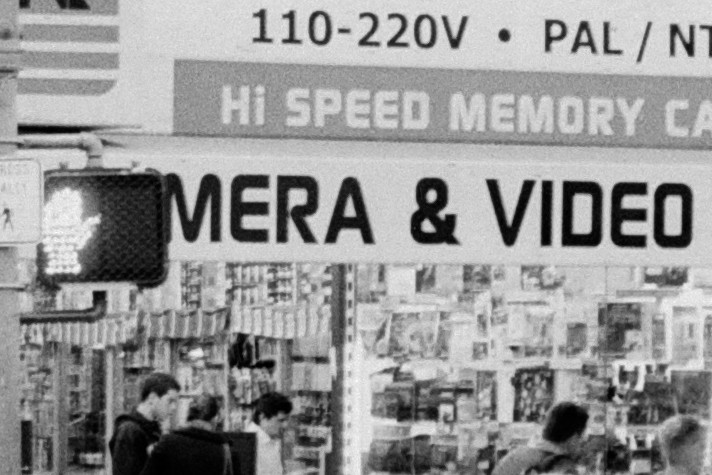"Best" is arguably a purpose built negative / slide scanner.
Good ones will provide resolutions in excess of what your original contains, and will not be cheap. without checking I'd guestimate many hundreds to several thousands of dollars.
There is a whole world of low to middle quality scanners / USB connected imagers etc. The cheapest probably start in the "few tens of dollars range - essentially a USB connected webcam with some optics and mounting frame to hold film and to ensure that the image uses most of the sensor area.
Results are probably roughly proportional to cost. A $US50 one (based on prices here in $NZ plus a US discount) can produce good enough quality that you would not be utterly disappointed BUT are certainly not going to be archival quality.
You can fit negative and film frames to some flatbed scanners BUT the resolution per slide etc is low to very low as while the scanner may have fairly high dpi sensors the area scanned i low so you don't get enough d'.
With a suitable [tm] macro lens and almost any DSLR and care with lighting you can photograph slides / negatives directly to memory and get results mainly limited by the lens and lighting quality.
OR - you can get a superb result by using a projector of adequate quality projecting to a screen - back projected makes life easier, plus tripod mounted and optimised APSC or better camera. Available area is whatever you want to make it, quality is controlled mainly by the projector capability and with care you can get close to "perfect" copies of the projected image. Even when centred on a back projected image you can have issues with distortion due to proximity and I imagine that a long focal length and requisite distance from screen would help.
You can get moderately good results from same side of screen photographing but add parallax errors and dealing with spill light from the projector.
Once setup you can acquire pictures at about the rate that you can display them.
This method is adding quality loss from projector and screen capture. It needs to be compared with direct photographing of backlit slide using a DSLR or any quality camera with more than about 5 MP resolution. More MP helps, and one can happily descend into line pairs per inch discussions of film, but a quality 5MP camera and good lighting and setup can produce a very acceptable result in most cases and you can use 6/10/12/18/24/36/ ... MP if desired.
6" x 4" at 300 dpi = 2.16 MP
12 x 8 x 300 dpi = 8.64 MP
Extended discussions and calculations elsewhere indicate that 300 dpi at output resolution is more than adequate for colour photos.
[Flame shields up].
Flying spot scanner - Gold standard (arguably) gold prices
Direct to DSLR from backlit negative using std lens with extension tubes (cheapish).
here
A resultant image - how that compares to what could be done with best methods I know not.
Direct DSLR - reasonable result:
35mm slide input.
Another direct to DSLR method - uses glass coffee table (or sheet) as a backlit workholder.
Here
Results here & here & here
Result 1 copied at end of this post.
DIY lightreflective adapter to use with std scanner here
EPSON Perfection V330 photo scanner.
You tube demo
HP use our scanners to do it ad - poor resolution
2011 - 2012 comment from here
In deciding how to scan these images, we did a lot of research online. We have had very good results for years from my Epson scanner. The Epson Perfection 4490 Photo Scanner is an example of the more recent kind of scanner. However, we have also had excellent results with Canon scanners.
After considerable review, we decided on the Canon 8800F. I am very pleased with the quality as well as the speed of this scanner. The scanner allows you to scan both in reflective mode and transmitted light mode. I have found the transmitted light mode to be somewhat cranky. Since the quality of some of my negatives is very poor, the scanner cannot detect some of the pictures and sometimes splits one picture into two. However, by working with the position of the negative on the scanning bed, I have solved most of those problems.
Nikon Coolscan 5000 with the SF-210 slide feeder attachment. It cost about $1400
I found that 2000dpi was good; light infra-red dust cleaning helped; light grain reduction was useful on negatives (not as needed on slides). On some older slides, it helped to place a AA battery towards the left side of the slide feeder pusher (where there was already a little notch), to help “spread out” the slides ever so slightly, in order to help avoid having two slides try to go at once, and also to avoid the insides of two slides from hooking onto each other. My grandfather’s slides from the 1950s were better when dusted off using a camel-hair photo brush (though slight scratching can happen from this, too, so I didn’t use the brush when not needed. Pros use air compressors to blow dust off).
THe image below is copied from the referenced page.
To me this seems entirely legitimate (ie moral, ethical and legal and also fair) application of "Fair use" provisos of copyright legislation and I cannot imagine how others could not agree. But, I know others may not :-).
If others feel others-wise feel free to modify as your guiding lights lead you.
See "Direct DSLR - reasonable result:" above.
35mm slide or full frame negative input.
Image from here http://d2f29brjr0xbt3.cloudfront.net/042_scanningnegatives/example1_large.jpg
from page http://photo.tutsplus.com/tutorials/shooting/scanning-negatives-with-your-digital-camera/
Actual image is about 2 x edge size / 4 x area of what is displayed on a full HD monitor at pixel per pixel resolution.

Crop




